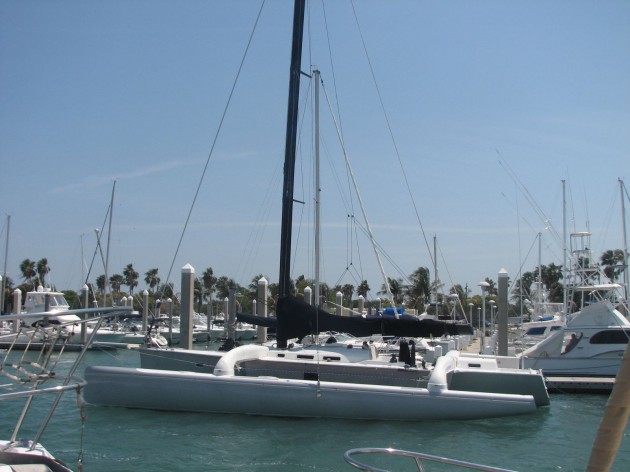Advertisement
Advertisement
Perry Design Review: Contour 44
High-performance tri with big-boat cruising features
September 29, 2000
We have a large and very active fleet of swing-wing trimarans in Seattle, but none are as big as this new tri designed by Rob Lambden and built by Contour Yachts of Ontario, Canada. This is an aggressive and sexy design that clearly falls into the category of very high-performance cruising.
The main hull has only a 5-foot beam at waterline, which gives the 44 a 9-to-1 ratio for LWL/BWL. The prismatic is high at .68 compared to a normal monohull prismatic of .54, which means there is a lot of volume in the ends of the main hull. The amas are designed to 200-percent buoyancy of the total displacement. The maximum righting moment of this tri is 150,000 foot pounds. Keeping the longitudinal center of buoyancy well forward will help prevent the 44 from digging in its leeward ama bow and flipping. I hate it when that happens. It happened to a 40-foot tri in Seattle last year.
Comparing this layout to that of a 44-foot monohull takes some adjusting. To begin with, the amas are big enough for each to house two additional berths. If you combine the ama berths with those in the main hull you get sleeping space for 10 without using the settees. The galley is tight and cooking for a big crew would be challenging. Note again there is no counter space inboard of the sinks. My guess is that kids would love to sleep in the ama cabins.
Note the large utility room at the base of the companionway. This will double as a shower and wet locker el grande. The flared topsides to the narrow hulls give the 44 a deceptive amount of usable interior volume. I think this 44 will feel like a big boat below. There are certainly enough fixed hull ports and cabintrunk windows to give this layout a very light and airy feel.
With 28 feet of overall, ama-extended beam to work with, the 44 has all the deck space you could ever need. Beam with the amas retracted is 12 feet. The cockpit is moderate in size and extends well beyond the beam limit of the main hull. I think with this amount of gross deck area the physical dimensions of the actual cockpit well are not too important.
The rig drawing shows a rotating mast and long retractable bowsprit for the asymmetrical chute. The SA/D is 22.75. I'm certain that in any decent breeze this boat will be a rocket. The ultra-high righting moment means that spar and rigging specs will have to be massive to support the loads.
Two things concern me about trimarans. The pitchpoling issue certainly needs to be understood and appreciated, since it can and does happen on very rare occasions. (Technically I'm not sure what the designer can do to ensure that it won't happen; maybe we are in the same situation with big monohulls that capsize.) I also wonder, looking at the disposition of these amas at rest — each hovering about 4 inches above the zero-degree-heel flotation plane — if this boat, when in a cruising configuration with normal crew movement, will always be at some small heel angle and have a very quick motion. Of course, if the boat were loaded to a point that the tips of each ama bottom were immersed, this heel angle would disappear though the motion would still be very quick. There must be some trade-off for the extremes of performance possible in this relatively radical cruising design. It will be up to the individual sailor to balance those elements.
Reservations aside, I'd line up to be one of the first to take my family cruising in this exciting new design.
Boat Specifications
LOA44'11"
LWL40'10"
Beam28'
Draft3'11" (board up), 8'6" (board down)
Displacement11,000 lbs.
Sail Area1,100 sq. ft.
SA/D22.75
D/L70
 This story originally appeared in Sailing Magazine, and is republished here by permission. Subscribe to Sailing.
This story originally appeared in Sailing Magazine, and is republished here by permission. Subscribe to Sailing.Advertisement
Related Boats for Sale
See more boats like thisAdvertisement


















